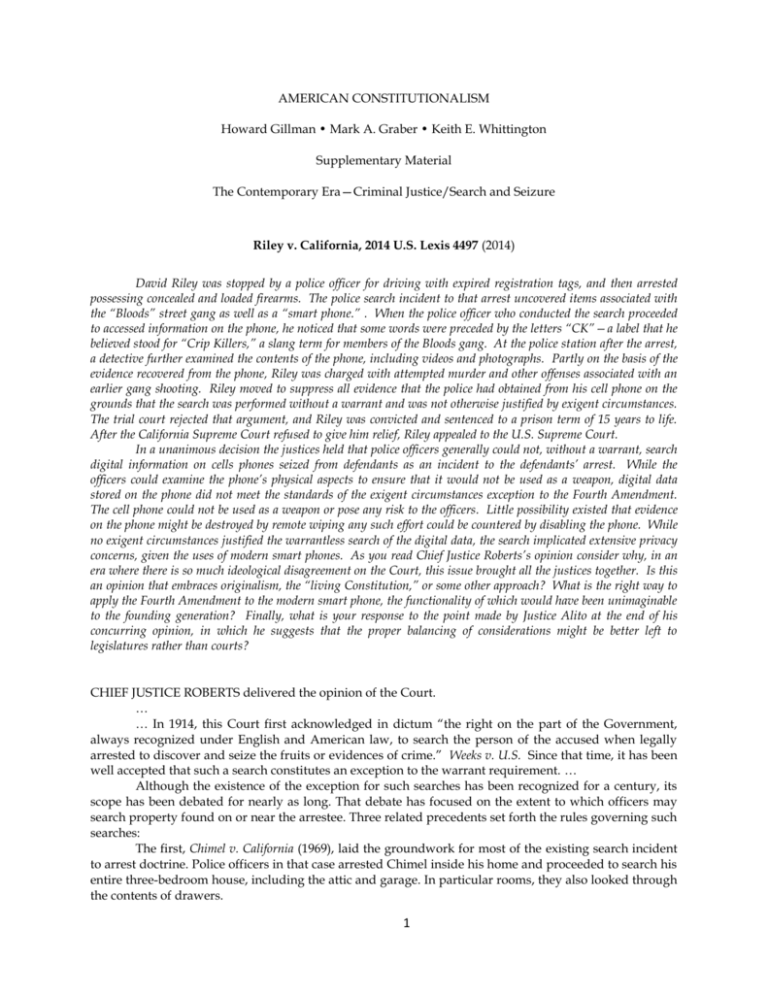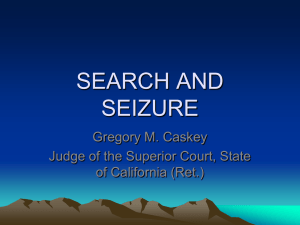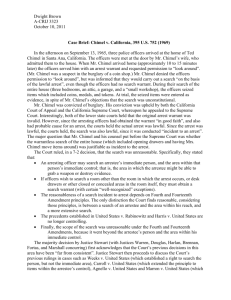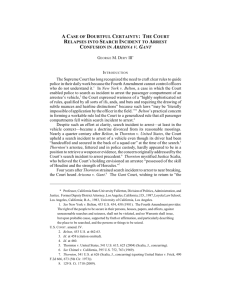Riley v California
advertisement

AMERICAN CONSTITUTIONALISM Howard Gillman • Mark A. Graber • Keith E. Whittington Supplementary Material The Contemporary Era—Criminal Justice/Search and Seizure Riley v. California, 2014 U.S. Lexis 4497 (2014) David Riley was stopped by a police officer for driving with expired registration tags, and then arrested possessing concealed and loaded firearms. The police search incident to that arrest uncovered items associated with the “Bloods” street gang as well as a “smart phone.” . When the police officer who conducted the search proceeded to accessed information on the phone, he noticed that some words were preceded by the letters “CK”—a label that he believed stood for “Crip Killers,” a slang term for members of the Bloods gang. At the police station after the arrest, a detective further examined the contents of the phone, including videos and photographs. Partly on the basis of the evidence recovered from the phone, Riley was charged with attempted murder and other offenses associated with an earlier gang shooting. Riley moved to suppress all evidence that the police had obtained from his cell phone on the grounds that the search was performed without a warrant and was not otherwise justified by exigent circumstances. The trial court rejected that argument, and Riley was convicted and sentenced to a prison term of 15 years to life. After the California Supreme Court refused to give him relief, Riley appealed to the U.S. Supreme Court. In a unanimous decision the justices held that police officers generally could not, without a warrant, search digital information on cells phones seized from defendants as an incident to the defendants’ arrest. While the officers could examine the phone’s physical aspects to ensure that it would not be used as a weapon, digital data stored on the phone did not meet the standards of the exigent circumstances exception to the Fourth Amendment. The cell phone could not be used as a weapon or pose any risk to the officers. Little possibility existed that evidence on the phone might be destroyed by remote wiping any such effort could be countered by disabling the phone. While no exigent circumstances justified the warrantless search of the digital data, the search implicated extensive privacy concerns, given the uses of modern smart phones. As you read Chief Justice Roberts’s opinion consider why, in an era where there is so much ideological disagreement on the Court, this issue brought all the justices together. Is this an opinion that embraces originalism, the “living Constitution,” or some other approach? What is the right way to apply the Fourth Amendment to the modern smart phone, the functionality of which would have been unimaginable to the founding generation? Finally, what is your response to the point made by Justice Alito at the end of his concurring opinion, in which he suggests that the proper balancing of considerations might be better left to legislatures rather than courts? CHIEF JUSTICE ROBERTS delivered the opinion of the Court. … … In 1914, this Court first acknowledged in dictum “the right on the part of the Government, always recognized under English and American law, to search the person of the accused when legally arrested to discover and seize the fruits or evidences of crime.” Weeks v. U.S. Since that time, it has been well accepted that such a search constitutes an exception to the warrant requirement. … Although the existence of the exception for such searches has been recognized for a century, its scope has been debated for nearly as long. That debate has focused on the extent to which officers may search property found on or near the arrestee. Three related precedents set forth the rules governing such searches: The first, Chimel v. California (1969), laid the groundwork for most of the existing search incident to arrest doctrine. Police officers in that case arrested Chimel inside his home and proceeded to search his entire three-bedroom house, including the attic and garage. In particular rooms, they also looked through the contents of drawers. 1 The Court crafted the following rule for assessing the reasonableness of a search incident to arrest: “When an arrest is made, it is reasonable for the arresting officer to search the person arrested in order to remove any weapons that the latter might seek to use in order to resist arrest or effect his escape. Otherwise, the officer’s safety might well be endangered, and the arrest itself frustrated. In addition, it is entirely reasonable for the arresting officer to search for and seize any evidence on the arrestee’s person in order to prevent its concealment or destruction. . . . There is ample justification, therefore, for a search of the arrestee’s person and the area ‘within his immediate control’— construing that phrase to mean the area from within which he might gain possession of a weapon or destructible evidence.” The extensive warrantless search of Chimel’s home did not fit within this exception, because it was not needed to protect officer safety or to preserve evidence. Four years later, in United States v. Robinson (1973), the Court applied the Chimel analysis in the context of a search of the arrestee’s person. A police officer had arrested Robinson for driving with a revoked license. The officer conducted a patdown search and felt an object that he could not identify in Robinson’s coat pocket. He removed the object, which turned out to be a crumpled cigarette package, and opened it. Inside were 14 capsules of heroin. … This Court … concluded that the search of Robinson was reasonable even though there was no concern about the loss of evidence, and the arresting officer had no specific concern that Robinson might be armed. In doing so, the Court did not draw a line between a search of Robinson’s person and a further examination of the cigarette pack found during that search. It merely noted that, “[h]aving in the course of a lawful search come upon the crumpled package of cigarettes, [the officer] was entitled to inspect it.” … The search incident to arrest trilogy concludes with Gant, which analyzed searches of an arrestee’s vehicle. Gant, like Robinson, recognized that the Chimel concerns for officer safety and evidence preservation underlie the search incident to arrest exception. As a result, the Court concluded that Chimel could authorize police to search a vehicle “only when the arrestee is unsecured and within reaching distance of the passenger compartment at the time of the search.” Gant added, however, an independent exception for a warrantless search of a vehicle’s passenger compartment “when it is ‘reasonable to believe evidence relevant to the crime of arrest might be found in the vehicle.’” That exception stems not from Chimel, the Court explained, but from “circumstances unique to the vehicle context.” … These cases require us to decide how the search incident to arrest doctrine applies to modern cell phones, which are now such a pervasive and insistent part of daily life that the proverbial visitor from Mars might conclude they were an important feature of human anatomy. A smart phone of the sort taken from Riley was unheard of ten years ago; a significant majority of American adults now own such phones. …. Absent more precise guidance from the founding era, we generally determine whether to exempt a given type of search from the warrant requirement “by assessing, on the one hand, the degree to which it intrudes upon an individual’s privacy and, on the other, the degree to which it is needed for the promotion of legitimate governmental interests.”… … Digital data stored on a cell phone cannot itself be used as a weapon to harm an arresting officer or to effectuate the arrestee’s escape. Law enforcement officers remain free to examine the physical aspects of a phone to ensure that it will not be used as a weapon—say, to determine whether there is a razor blade hidden between the phone and its case. Once an officer has secured a phone and eliminated any potential physical threats, however, data on the phone can endanger no one. Perhaps the same might have been said of the cigarette pack seized from Robinson’s pocket. Once an officer gained control of the pack, it was unlikely that Robinson could have accessed the pack’s contents. But unknown physical objects may always pose risks, no matter how slight, during the tense atmosphere of a custodial arrest. … No such unknowns exist with respect to digital data. … 2 … The United States and California focus primarily on the second Chimel rationale: preventing the destruction of evidence. … … The briefing reveals only a couple of anecdotal examples of remote wiping triggered by an arrest. Similarly, the opportunities for officers to search a password-protected phone before data becomes encrypted are quite limited. … Moreover, in situations in which an arrest might trigger a remote-wipe attempt or an officer discovers an unlocked phone, it is not clear that the ability to conduct a warrantless search would make much of a difference. The need to effect the arrest, secure the scene, and tend to other pressing matters means that law enforcement officers may well not be able to turn their attention to a cell phone right away. … Cell phone data would be vulnerable to remote wiping from the time an individual anticipates arrest to the time any eventual search of the phone is completed, which might be at the station house hours later. Likewise, an officer who seizes a phone in an unlocked state might not be able to begin his search in the short time remaining before the phone locks and data becomes encrypted. In any event, as to remote wiping, law enforcement is not without specific means to address the threat. Remote wiping can be fully prevented by disconnecting a phone from the network. There are at least two simple ways to do this: First, law enforcement officers can turn the phone off or remove its battery. Second, if they are concerned about encryption or other potential problems, they can leave a phone powered on and place it in an enclosure that isolates the phone from radio waves. Such devices are commonly called “Faraday bags,” after the English scientist Michael Faraday. They are essentially sandwich bags made of aluminum foil: cheap, lightweight, and easy to use. … To the extent that law enforcement still has specific concerns about the potential loss of evidence in a particular case, there remain more targeted ways to address those concerns. If “the police are truly confronted with a ‘now or never’ situation,”—for example, circumstances suggesting that a defendant’s phone will be the target of an imminent remote-wipe attempt—they may be able to rely on exigent circumstances to search the phone immediately… … The search incident to arrest exception rests not only on the heightened government interests at stake in a volatile arrest situation, but also on an arrestee’s reduced privacy interests upon being taken into police custody. … The United States asserts that a search of all data stored on a cell phone is “materially indistinguishable” from searches of … physical items [such as wallets or purses]. That is like saying a ride on horseback is materially indistinguishable from a flight to the moon. Both are ways of getting from point A to point B, but little else justifies lumping them together. Modern cell phones, as a category, implicate privacy concerns far beyond those implicated by the search of a cigarette pack, a wallet, or a purse. A conclusion that inspecting the contents of an arrestee’s pockets works no substantial additional intrusion on privacy beyond the arrest itself may make sense as applied to physical items, but any extension of that reasoning to digital data has to rest on its own bottom. … Cell phones differ in both a quantitative and a qualitative sense from other objects that might be kept on an arrestee’s person. The term “cell phone” is itself misleading shorthand; many of these devices are in fact minicomputers that also happen to have the capacity to be used as a telephone. They could just as easily be called cameras, video players, rolodexes, calendars, tape recorders, libraries, diaries, albums, televisions, maps, or newspapers. One of the most notable distinguishing features of modern cell phones is their immense storage capacity. Before cell phones, a search of a person was limited by physical realities and tended as a general matter to constitute only a narrow intrusion on privacy. Most people cannot lug around every piece of mail they have received for the past several months, every picture they have taken, or every book or article they have read—nor would they have any reason to attempt to do so. And if they did, they would have to drag behind them a trunk of the sort held to require a search warrant in Chadwick, rather than a container the size of the cigarette package in Robinson. 3 But the possible intrusion on privacy is not physically limited in the same way when it comes to cell phones. The current top-selling smart phone has a standard capacity of 16 gigabytes (and is available with up to 64 gigabytes). Sixteen gigabytes translates to millions of pages of text, thousands of pictures, or hundreds of videos. Cell phones couple that capacity with the ability to store many different types of information: Even the most basic phones that sell for less than $20 might hold photographs, picture messages, text messages, Internet browsing history, a calendar, a thousand-entry phone book, and so on. We expect that the gulf between physical practicability and digital capacity will only continue to widen in the future. The storage capacity of cell phones has several interrelated consequences for privacy. First, a cell phone collects in one place many distinct types of information—an address, a note, a prescription, a bank statement, a video—that reveal much more in combination than any isolated record. Second, a cell phone’s capacity allows even just one type of information to convey far more than previously possible. The sum of an individual’s private life can be reconstructed through a thousand photographs labeled with dates, locations, and descriptions; the same cannot be said of a photograph or two of loved ones tucked into a wallet. Third, the data on a phone can date back to the purchase of the phone, or even earlier. A person might carry in his pocket a slip of paper reminding him to call Mr. Jones; he would not carry a record of all his communications with Mr. Jones for the past several months, as would routinely be kept on a phone. Finally, there is an element of pervasiveness that characterizes cell phones but not physical records. Prior to the digital age, people did not typically carry a cache of sensitive personal information with them as they went about their day. Now it is the person who is not carrying a cell phone, with all that it contains, who is the exception. According to one poll, nearly three-quarters of smart phone users report being within five feet of their phones most of the time, with 12% admitting that they even use their phones in the shower. A decade ago police officers searching an arrestee might have occasionally stumbled across a highly personal item such as a diary. But those discoveries were likely to be few and far between. Today, by contrast, it is no exaggeration to say that many of the more than 90% of American adults who own a cell phone keep on their person a digital record of nearly every aspect of their lives— from the mundane to the intimate. Allowing the police to scrutinize such records on a routine basis is quite different from allowing them to search a personal item or two in the occasional case. Although the data stored on a cell phone is distinguished from physical records by quantity alone, certain types of data are also qualitatively different. An Internet search and browsing history, for example, can be found on an Internet-enabled phone and could reveal an individual’s private interests or concerns—perhaps a search for certain symptoms of disease, coupled with frequent visits to WebMD. Data on a cell phone can also reveal where a person has been. Historic location information is a standard feature on many smart phones and can reconstruct someone’s specific movements down to the minute, not only around town but also within a particular building. Mobile application software on a cell phone, or “apps,” offer a range of tools for managing detailed information about all aspects of a person’s life. There are apps for Democratic Party news and Republican Party news; apps for alcohol, drug, and gambling addictions; apps for sharing prayer requests; apps for tracking pregnancy symptoms; apps for planning your budget; apps for every conceivable hobby or pastime; apps for improving your romantic life. There are popular apps for buying or selling just about anything, and the records of such transactions may be accessible on the phone indefinitely. There are over a million apps available in each of the two major app stores; the phrase “there’s an app for that” is now part of the popular lexicon. The average smart phone user has installed 33 apps, which together can form a revealing montage of the user’s life. In 1926, Learned Hand observed (in an opinion later quoted in Chimel) that it is “a totally different thing to search a man’s pockets and use against him what they contain, from ransacking his house for everything which may incriminate him.” If his pockets contain a cell phone, however, that is no longer true. Indeed, a cell phone search would typically expose to the government far more than the most exhaustive search of a house: A phone not only contains in digital form many sensitive records previously found in the home; it also contains a broad array of private information never found in a home in any form—unless the phone is. 4 …… We cannot deny that our decision today will have an impact on the ability of law enforcement to combat crime. Cell phones have become important tools in facilitating coordination and communication among members of criminal enterprises, and can provide valuable incriminating information about dangerous criminals. Privacy comes at a cost. Our holding, of course, is not that the information on a cell phone is immune from search; it is instead that a warrant is generally required before such a search, even when a cell phone is seized incident to arrest. … … In light of the availability of the exigent circumstances exception, there is no reason to believe that law enforcement officers will not be able to address some of the more extreme hypotheticals that have been suggested: a suspect texting an accomplice who, it is feared, is preparing to detonate a bomb, or a child abductor who may have information about the child’s location on his cell phone. The defendants here recognize—indeed, they stress—that such fact-specific threats may justify a warrantless search of cell phone data. The critical point is that, unlike the search incident to arrest exception, the exigent circumstances exception requires a court to examine whether an emergency justified a warrantless search in each particular case. … Our cases have recognized that the Fourth Amendment was the founding generation’s response to the reviled “general warrants” and “writs of assistance” of the colonial era, which allowed British officers to rummage through homes in an unrestrained search for evidence of criminal activity. Opposition to such searches was in fact one of the driving forces behind the Revolution itself. In 1761, the patriot James Otis delivered a speech in Boston denouncing the use of writs of assistance. A young John Adams was there, and he would later write that “[e]very man of a crowded audience appeared to me to go away, as I did, ready to take arms against writs of assistance.” According to Adams, Otis’s speech was “the first scene of the first act of opposition to the arbitrary claims of Great Britain. Then and there the child Independence was born.” Modern cell phones are not just another technological convenience. With all they contain and all they may reveal, they hold for many Americans “the privacies of life,” Boyd. The fact that technology now allows an individual to carry such information in his hand does not make the information any less worthy of the protection for which the Founders fought. Our answer to the question of what police must do before searching a cell phone seized incident to an arrest is accordingly simple—get a warrant. … JUSTICE ALITO, concurring in part and concurring in the judgment. I agree with the Court that law enforcement officers, in conducting a lawful search incident to arrest, must generally obtain a warrant before searching information stored or accessible on a cell phone. I write separately to address two points. … First, I am not convinced at this time that the ancient rule on searches incident to arrest is based exclusively (or even primarily) on the need to protect the safety of arresting officers and the need to prevent the destruction of evidence. This rule antedates the adoption of the Fourth Amendment by at least a century. … … Despite my view on the point discussed above, I agree that we should not mechanically apply the rule used in the predigital era to the search of a cell phone. Many cell phones now in use are capable of storing and accessing a quantity of information, some highly personal, that no person would ever have had on his person in hard-copy form. This calls for a new balancing of law enforcement and privacy interests. The Court strikes this balance in favor of privacy interests with respect to all cell phones and all information found in them, and this approach leads to anomalies. For example, the Court’s broad holding favors information in digital form over information in hard-copy form. Suppose that two suspects are 5 arrested. Suspect number one has in his pocket a monthly bill for his land-line phone, and the bill lists an incriminating call to a long-distance number. He also has in his a wallet a few snapshots, and one of these is incriminating. Suspect number two has in his pocket a cell phone, the call log of which shows a call to the same incriminating number. In addition, a number of photos are stored in the memory of the cell phone, and one of these is incriminating. Under established law, the police may seize and examine the phone bill and the snapshots in the wallet without obtaining a warrant, but under the Court’s holding today, the information stored in the cell phone is out. While the Court’s approach leads to anomalies, I do not see a workable alternative. Law enforcement officers need clear rules regarding searches incident to arrest, and it would take many cases and many years for the courts to develop more nuanced rules. And during that time, the nature of the electronic devices that ordinary Americans carry on their persons would continue to change. … This brings me to my second point. While I agree with the holding of the Court, I would reconsider the question presented here if either Congress or state legislatures, after assessing the legitimate needs of law enforcement and the privacy interests of cell phone owners, enact legislation that draws reasonable distinctions based on categories of information or perhaps other variables…. … Modern cell phones are of great value for both lawful and unlawful purposes. They can be used in committing many serious crimes, and they present new and difficult law enforcement problems. At the same time, because of the role that these devices have come to play in contemporary life, searching their contents implicates very sensitive privacy interests that this Court is poorly positioned to understand and evaluate. Many forms of modern technology are making it easier and easier for both government and private entities to amass a wealth of information about the lives of ordinary Americans, and at the same time, many ordinary Americans are choosing to make public much information that was seldom revealed to outsiders just a few decades ago. In light of these developments, it would be very unfortunate if privacy protection in the 21st century were left primarily to the federal courts using the blunt instrument of the Fourth Amendment. Legislatures, elected by the people, are in a better position than we are to assess and respond to the changes that have already occurred and those that almost certainly will take place in the future. 6







